.....When
I was learning how to play pool there were no books, no videos,
no instructors and no leagues to play in. The best way to learn
was to watch. I was privileged to see some of the greatest and
some of the not so great. My purpose for publishing my pointers
insrtuctional column is not only to inpart pool knowledge to my
viewers but to share with the public what these great players from
the 1980s and 1990s looked like. Through my trusty Canon, for a
moment in time they are immortalized. Some are still here and some
are gone and I still remember the joy of watching them play.

DOUBLE OR NOTHING
When two heads are better than one
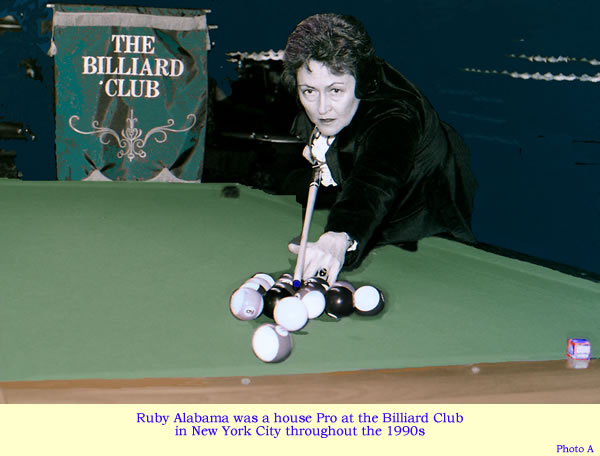
…..RUBY ALABAMA faced a difficult
dilemma during a straight pool tournament at the Billiard Club
in New York City in which she needed just five balls to close out
her match. (Read more
about Ruby Alabama on my Billie-isms page.) Her opponent had
played safe, leaving the cue ball and an object ball behind a full
rack of balls. Ruby had to either make a difficult shot or play
a difficult safety. Both of these options were complicated because
Alabama had to shoot over the entire stack to reach the cue ball.
Initially, she attempted to stretch over the balls with just an
over-the-ball hand bridge. (Photo
A). But
then she realized she would have to execute either move with the
mechanical bridge.
…..The dreaded mechanical
bridge! My students invariably moan whenever I broach the topic.
Over the years, I've been surprised at how few pros use the "rake" correctly.
The truth is if you learn to use the mechanical bridge properly
- and to its fullest - you'll learn to love it.

…..Few players realize the
bridge's full potential. Using one bridge to shoot over an object
ball, and two "interlocking" bridge
heads to reach over two or three balls, are the more conventional
methods. But what do you do when you need to shoot over five or
six (or more!) balls?
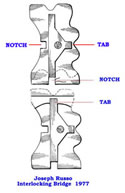 …..In
this situation,
(Photo B) Ruby tried to place one bridge
on top of the other without the use of two Russo interlocking bridges.
She held the two bridge handles securely with her left hand. (Photo
C) A good choice in other circumstances, the Russo Bridge is a
great idea for stabilizing the mechanical bridge while elevating
the cue stick to greater than normal heights. The Russo Bridge
has a billiard bridge head fix mounted to a stick and includes
an interlocking tab and notch assembly which can conveniently interlink
with the head of another Russo bridge. The two joined bridges are
then capable of supporting a cue stick at selectively variable
heights which can be greater than the height of any single bridge.
Pictured on the left, Nick Varner uses two Russo bridges to shoot
over one ball that is out of his normal reach. In this case, he
successfully shoots the 9 ball in the upper corner pocket to continue
his run. …..In
this situation,
(Photo B) Ruby tried to place one bridge
on top of the other without the use of two Russo interlocking bridges.
She held the two bridge handles securely with her left hand. (Photo
C) A good choice in other circumstances, the Russo Bridge is a
great idea for stabilizing the mechanical bridge while elevating
the cue stick to greater than normal heights. The Russo Bridge
has a billiard bridge head fix mounted to a stick and includes
an interlocking tab and notch assembly which can conveniently interlink
with the head of another Russo bridge. The two joined bridges are
then capable of supporting a cue stick at selectively variable
heights which can be greater than the height of any single bridge.
Pictured on the left, Nick Varner uses two Russo bridges to shoot
over one ball that is out of his normal reach. In this case, he
successfully shoots the 9 ball in the upper corner pocket to continue
his run.
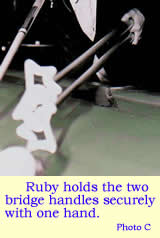 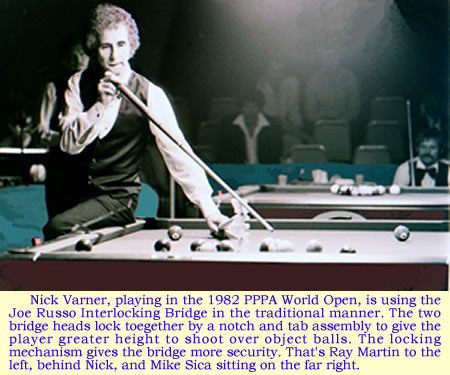
…..However, Ruby was in an unusual
position. She eyed the shot and lined up the notch of the bridge
head with the center of the cue ball. (Photo
D) Then she tried to
shoot over the stack and realized that not only was the shot tricky,
but she had low visibility. (Photo E)
The
two bridge head method was not working for Ruby as she
was still reaching too far to feel confident of her shot.
.....And then
she remembered a lesson from my "1001 Uses For The Mechanical
Bridge" class
which she had taken before becoming a tournament player.
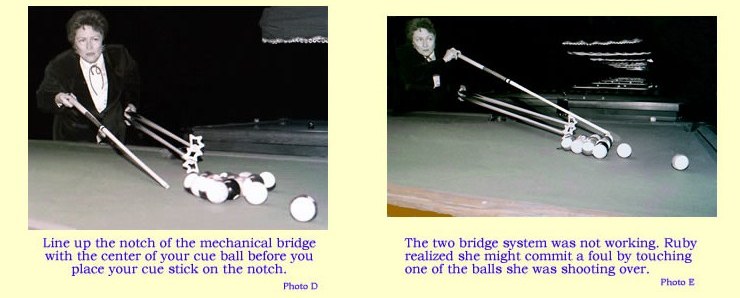

…..What
Ruby opted for was the "crane" technique,
which allows the shooter a longer reach, more height and better
sighting on the cueball and object ball. She simply placed one
bridge on the table in front of the object balls. Then she placed
the shaft of
the second bridge on the head of the first bridge (as you would
your cue on a normal shot), and slid the second bridge head out
above the cluster of balls. (Photo F)
.…..Originally, Alabama
had the bottom bridge about 8” from
the rack. (Photo G)
She could see
that she was barely getting over all the balls. By adjusting the
bottom bridge to 4” (albeit
moving closer) she was able to get even more height and a better
cueing position. (Photo H)
...
.....The
bottom mechanical bridge handle was resting on the table while
Ruby held onto the second handle with her bridge hand.
(Photo
I)
Finally, she
glided the shaft of her cue well in front of the second bridge
head and took aim at the cue ball.
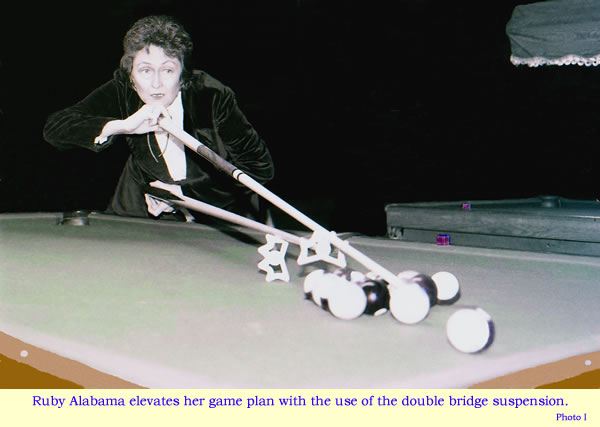
Through
the use of the "crane" or “suspension” technique
(being a New Yorker, I call it the Verrazano Bridge), Ruby pocketed
the otherwise unreachable shot, broke open the stack, and ran the
five balls needed to win the game.
….........Knowing all the options
available with the mechanical bridge will help lift you through
some tough situations.


.....Pool Pointer Archives
.....1. Closed Half-Bridge
.....2. Look Before You Leap
.....3. Mechanically
Inclined
.....4. Keep a Level Cue
.....5. Double or Nothing
.....Tune
in for more Pointer articles coming
your way each month.

|

